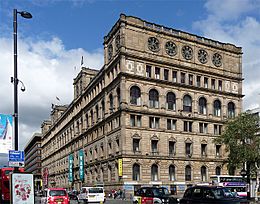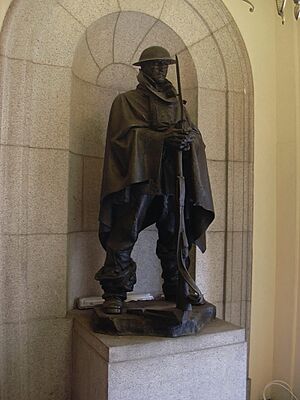Watts Warehouse facts for kids
Quick facts for kids Watts Warehouse, Manchester |
|
|---|---|

Britannia Hotel (formerly Watts Warehouse)
|
|
| General information | |
| Architectural style | Wholesale warehouse in eclectic Venetian Palazzo style |
| Town or city | Manchester |
| Country | United Kingdom |
| Coordinates | 53°28′44″N 2°14′14″W / 53.47895°N 2.237286°W |
| Construction started | 1851 |
| Completed | 1856 |
| Cost | £100,000 |
| Design and construction | |
| Architect | Travis & Magnell |
|
Listed Building – Grade II*
|
|
| Official name | Britannia Hotel |
| Designated | 25 February 1952 |
| Reference no. | 1246952 |
Watts Warehouse is a huge, beautiful Victorian building in Manchester, England. It's so special, it's called a Grade II* listed building. It opened in 1856 as a place to store and sell fabrics for a company called S & J Watts. It was the biggest fabric warehouse in Manchester at the time. Today, this amazing building is part of the Britannia Hotels chain.
Contents
History of Watts Warehouse
The Watts Family Story
The company S & J Watts Limited was started by James Watts (Mayor of Manchester). He was a successful businessman from Manchester. His fabric business began in a small house in Didsbury. James Watts became very rich from selling cotton. This was during a time in the 1800s when Manchester was known as "Cottonopolis". It was a global center for the cotton trade.
James Watts became an important person among British business leaders. He even met with politicians and church leaders at his home, Abney Hall. Prince Albert, the Queen's husband, stayed with him when he visited Manchester in 1857. The Watts family is also distantly related to the famous writer Agatha Christie.
Building the Warehouse
The Watts Warehouse was built between 1851 and 1856. It cost a lot of money, about £100,000. Local architects Travis & Mangnall designed it. The building's fancy style shows how confident and rich Manchester was back then.
The design is very unique. It looks like a Venetian palazzo (a grand Italian palace). The building has five floors, and each floor is decorated in a different style. You can see elements of Italian, Elizabethan, French, and Flemish designs. The roof even has large Gothic wheel windows.
The inside of the warehouse was just as grand. It had a sweeping iron staircase and beautiful mahogany counters. These were used to show off the fabrics for sale.
A Memorial for Heroes
During the First World War (1914–1918), many employees of S & J Watts died fighting. To remember them, the company put up a special memorial in 1922. It's in the main entrance of the building on Portland Street.
On one side, there's a bronze statue called "the Sentry." He's wearing a Tommy helmet and World War I battle gear. He stands guard with his rifle. This statue was made by a British sculptor named Charles Sargeant Jagger. On the other side, a marble plaque lists the names of those who died.
The memorial inscription says:
To the enduring memory of those members of the staff of S & J Watts & Co. who laid down their lives for their King and country in the cause of truth, justice and freedom during the Great War. Their name liveth for evermore.
—Memorial inscription, Watts Warehouse, Portland Street entrance
Surviving the Blitz
During the Second World War, the Watts Warehouse was hit by bombs from German planes. But it was saved! The fire was put out because it was smothered by all the textiles inside.
Becoming a Hotel
Over time, Manchester's fabric industry became less important. Like many other old industrial buildings, Watts Warehouse was not used for many years. It was almost torn down in 1972, but thankfully it was saved.
In the 1980s, the building was changed into a hotel. Many of its original features inside were kept. In May 1982, the Britannia Hotel opened. It started with 25 rooms and a nightclub. Later, it grew to have 363 bedrooms.
The building was officially made a Grade II* listed building in 1952. This means it's a very important historic place. The war memorial inside is also listed on the Imperial War Museum's register.
Images for kids



